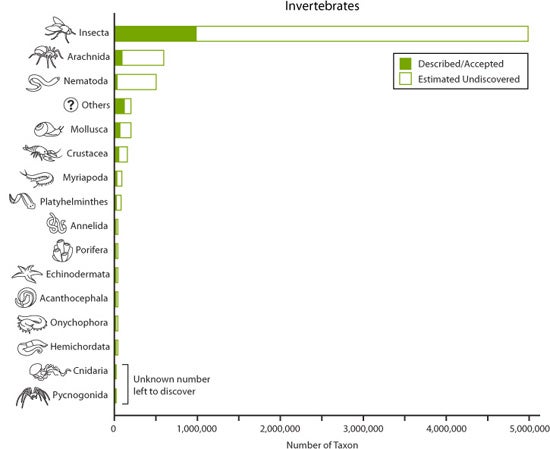How Many Species Call Planet Earth Home?
This is a question that has not been answered, and it may never be known. There are estimates of the total number of species that reach as high as 100 million. What biologists do know is there are a lot more species we do not know about than the ones we have found and named. So far scientists have only discovered and named around two million species. This is why there are so many scientists exploring our world looking for undiscovered life.
You Can Be Part of the Adventure
The job is not a small one as you can see from the graphs below. There are millions of living things that need to be found and given a name. There are places where biologists are in a race against time and disappearing habitat. Even places like city parks and possibly your back yard could be home to a new species.

Taking a closer look you can see how the search is going for Chordates.

There is even more work to be done with the invertebrates which include the world of insecta.

Becoming a Species Hunter
One of the best ways to learn about how to become a species hunter is to find a local group hosting a BioBlitz. These are 24 - 48 hour events where scientists and volunteers try to find and list all the living things in a given area. There are also special days each year when biologists and volunteers try to count all the birds, or butterflies they see in one day. These events are a perfect way to learn about living things and meet some of the people that are looking for new life every day.

Graph data from: Biodiversity: Australian Biological Resources Study. 2nd Edition. September 2009. Retrieved May 22, 2010 from https://www.environment.gov.au/science/abrs/publications/other/numbers-l....
Read more about: Linnaeus and the World of Taxonomy
Bibliographic details:
- Article: How Many Species Are There?
- Author(s): Dr. Biology
- Publisher: Arizona State University School of Life Sciences Ask A Biologist
- Site name: ASU - Ask A Biologist
- Date published:
- Date accessed:
- Link: https://askabiologist.asu.edu/species-graphs
APA Style
Dr. Biology. (). How Many Species Are There?. ASU - Ask A Biologist. Retrieved from https://askabiologist.asu.edu/species-graphs
Chicago Manual of Style
Dr. Biology. "How Many Species Are There?". ASU - Ask A Biologist. . https://askabiologist.asu.edu/species-graphs
Dr. Biology. "How Many Species Are There?". ASU - Ask A Biologist. . ASU - Ask A Biologist, Web. https://askabiologist.asu.edu/species-graphs
MLA 2017 Style

The amazing X-ray fish, or X-ray tetra (Pristella maxillaris). This chordate has a see-through body so you can look at its backbone.
Be Part of
Ask A Biologist
By volunteering, or simply sending us feedback on the site. Scientists, teachers, writers, illustrators, and translators are all important to the program. If you are interested in helping with the website we have a Volunteers page to get the process started.

